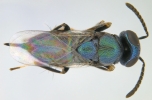Scientific name
Cerchysius laticeps Kerrich
Taxonomic position
Hymenoptera: Chalcidoidea: Encyrtidae
Diagnosis
Images

 Female, dorsal view Female, dorsal view
Distribution
India: Andhra Pradesh, Assam, Karnataka, Meghalaya. Malaysia (Hayat, 2006).
Hosts / Biology
The species of Cerchysius are parasitoids of Chamaemyiidae and Drosophilidae (Hayat, 2006). Cerchysius laticeps is mainly associated with predators of aphids and mealybugs such as Leucopis spp. (Chamaemyiidae) and Cacoxenus spp. (Drosophilidae).
Reference
- Hayat, M. 2006. Indian Encyrtidae (Hymenoptera: Chalcidoidea). Department of Zoology, Aligarh Muslim University. 496 p.
|